
Rhodochrosite is a manganese carbonate mineral with chemical composition MnCO3. In its pure form (rare), it is typically a rose-red colour, but it can also be shades of pink to pale brown. It streaks white, and its Mohs hardness varies between 3.5 and 4.5. Its specific gravity is between 3.45 and 3.6. It crystallizes in the trigonal system, and cleaves with rhombohedral carbonate cleavage in three directions. The crystal structure of rhodochrosite is a rhombohedral system, which is a subset of the trigonal system. The carbonate ions (CO3) are arranged in a triangular planar configuration, and the manganese ions (Mn) are surrounded by six oxygen ions in an octahedral arrangement. The MnO6 octahedra and CO3 triangles are linked together to form a three-dimensional structure. Crystal twinning often is present. It is often confused with the manganese silicate, rhodonite, but is distinctly softer. Rhodochrosite is formed by the oxidation of manganese ore, and is found in South Africa, China, and the Americas. It is officially listed as one of the National symbols of Argentina.

Cassiterite is a tin oxide mineral, SnO2. It is generally opaque, but it is translucent in thin crystals. Its luster and multiple crystal faces produce a desirable gem. Cassiterite was the chief tin ore throughout ancient history and remains the most important source of tin today.

Molybdenite is a mineral of molybdenum disulfide, MoS2. Similar in appearance and feel to graphite, molybdenite has a lubricating effect that is a consequence of its layered structure. The atomic structure consists of a sheet of molybdenum atoms sandwiched between sheets of sulfur atoms. The Mo-S bonds are strong, but the interaction between the sulfur atoms at the top and bottom of separate sandwich-like tri-layers is weak, resulting in easy slippage as well as cleavage planes. Molybdenite crystallizes in the hexagonal crystal system as the common polytype 2H and also in the trigonal system as the 3R polytype.

Acanthite is a form of silver sulfide with the chemical formula Ag2S. It crystallizes in the monoclinic system and is the stable form of silver sulfide below 173 °C (343 °F). Argentite is the stable form above that temperature. As argentite cools below that temperature its cubic form is distorted to the monoclinic form of acanthite. Below 173 °C acanthite forms directly. Acanthite is the only stable form in normal air temperature.
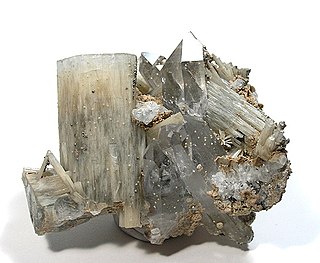
Zinnwaldite, KLiFeAl(AlSi3)O10(OH,F)2, potassium lithium iron aluminium silicate hydroxide fluoride is a silicate mineral in the mica group. The IMA status is as a series between siderophyllite (KFe2Al(Al2Si2)O10(F,OH)2) and polylithionite (KLi2AlSi4O10(F,OH)2) and not considered a valid mineral species.

Hübnerite or hubnerite is a mineral consisting of manganese tungsten oxide (chemical formula MnWO4). It is the manganese endmember of the manganese–iron wolframite solid solution series. It forms reddish brown to black monoclinic prismatic submetallic crystals. The crystals are typically flattened and occur with fine striations. It has a high specific gravity of 7.15 and a Mohs hardness of 4.5. It is transparent to translucent with perfect cleavage. Refractive index values are nα = 2.170 - 2.200, nβ = 2.220, and nγ = 2.300 - 2.320.

Bismuthinite is a mineral consisting of bismuth sulfide (Bi2S3). It is an important ore for bismuth. The crystals are steel-grey to off-white with a metallic luster. It is soft enough to be scratched with a fingernail and rather dense.

Bournonite is a sulfosalt mineral species, trithioantimoniate of lead and copper with the formula PbCuSbS3.

Greisen is a highly altered granitic rock or pegmatite, usually composed predominantly of quartz and micas. Greisen is formed by self-generated alteration of a granite and is a class of moderate- to high-temperature magmatic-hydrothermal alteration related to the late-stage release of volatiles dissolved in a magma during the solidification of that magma.
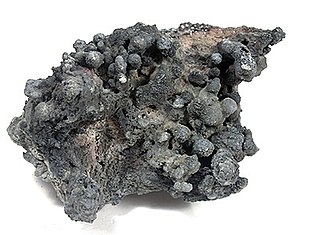
Rheniite is a very rare rhenium sulfide mineral with the chemical formula. It forms metallic, silver grey platey crystals in the triclinic - pinacoidal class. It has a specific gravity of 7.5.
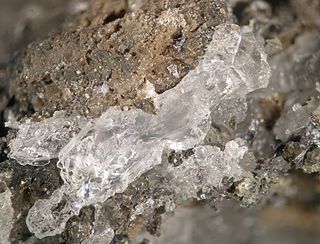
Evenkite is a rare hydrocarbon mineral with formula C24H50; specifically, H3C–(CH2)22–CH3, the alkane n-tetracosane. It occurs as very soft (Mohs hardness 1) transparent crystals, colorless to yellow, with a waxy luster. The softness is a characteristic of crystalline long-chain alkanes, which are the main constituents of paraffin wax.

Uranium ore deposits are economically recoverable concentrations of uranium within the Earth's crust. Uranium is one of the most common elements in the Earth's crust, being 40 times more common than silver and 500 times more common than gold. It can be found almost everywhere in rock, soil, rivers, and oceans. The challenge for commercial uranium extraction is to find those areas where the concentrations are adequate to form an economically viable deposit. The primary use for uranium obtained from mining is in fuel for nuclear reactors.

Alabandite or alabandine is a rarely occurring manganese sulfide mineral. It crystallizes in the cubic crystal system with the chemical composition Mn2+S and develops commonly massive to granular aggregates, but rarely also cubic or octahedral crystals to 1 cm.
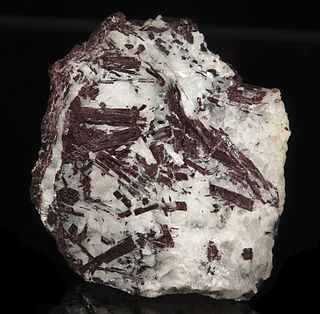
Piemontite is a sorosilicate mineral in the monoclinic crystal system with the chemical formula Ca2(Al,Mn3+,Fe3+)3(SiO4)(Si2O7)O(OH). It is a member of the epidote group.
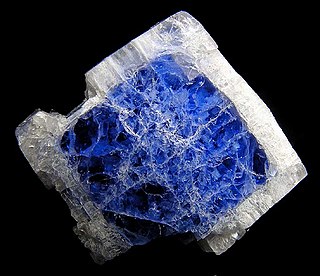
Carletonite is a rare silicate mineral with formula KNa4Ca4(CO3)4Si8O18(F,OH)·(H2O).

Woodhouseite belongs to the beudantite group AB3(XO4)(SO4)(OH)6 where A = Ba, Ca, Pb or Sr, B = Al or Fe and X = S, As or P. Minerals in this group are isostructural with each other and also with minerals in the crandallite and alunite groups. They crystallise in the rhombohedral system with space group R3m and crystals are usually either tabular {0001} or pseudo-cubic to pseudo-cuboctahedral. Woodhouseite was named after Professor Charles Douglas Woodhouse (1888–1975), an American mineralogist and mineral collector from the University of California, Santa Barbara, US, and one-time General Manager of Champion Sillimanite, Inc.
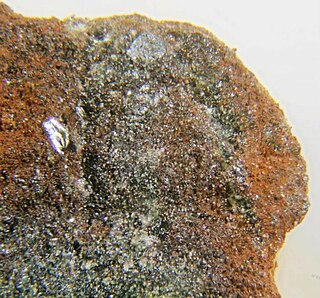
Minnesotaite is an iron silicate mineral with formula: (Fe2+,Mg)3Si4O10(OH)2. It crystallizes in the triclinic crystal system and occurs as fine needles and platelets with other silicates. It is isostructural with the pyrophyllite-talc mineral group.

Ferrimolybdite is a hydrous iron molybdate mineral with formula: Fe3+2(MoO4)3·8(H2O) or Fe3+2(MoO4)3·n(H2O). It forms coatings and radial aggregates of soft yellow needles which crystallize in the orthorhombic system.
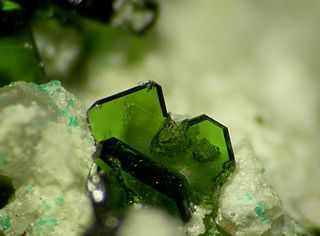
Lindgrenite is an uncommon copper molybdate mineral with formula: Cu3(MoO4)2(OH)2. It occurs as tabular to platey monoclinic green to yellow green crystals.

Szenicsite is a copper hydroxy molybdate mineral, named after husband and wife Terry and Marissa Szenics, American mineral collectors who found the first specimens. When it was first discovered in Atacama, Chile, it was thought to be lindgrenite. The occurrence appeared in an isolated area, which was about one cubic meter in size. The mineral occurred in cavities of copper bearing powellite and matrix rich molybdenite. These cavities were filled with a material resembling clay. Outside of the zone the szenicsite crystals grew, copper levels seemed to decrease, and the mineralization changed to lindgrenite. Moving further from the zone, the minerals growing seemed to be lacking copper, and consisted of powellite blebs in the ore. Szenicsite was approved by the IMA in 1993.




















